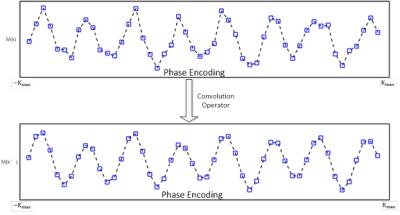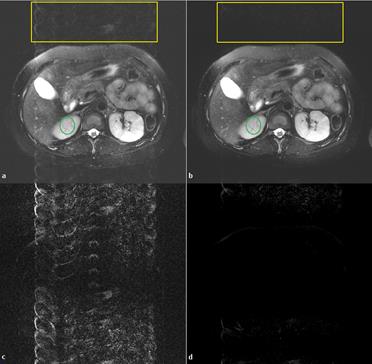1289
Motion Artifacts Reduction by Parallel Acquisition with Non-prolonged Deghosting Algorithm (PANDA)1Advanced Applications, Alltech Medical Systems, Chengdu, People's Republic of China, 2Advanced Applications, Alltech Medical Systems America, Solon, OH, United States, 3Radiology, University of British Columbia, Vancouver, BC, Canada
Synopsis
Patient motion produces artifacts in MRI due to k-space data corruption. Ghosted images can be considered as a combination of ghost-free images and ghost masks. If two ghosted images contain the same ghost-free image component and different ghost components, the images and the ghost components can be separated. For images fully sampled with array coils, multiple images can be produced with parallel reconstruction with differently selected raw data subsets. In this work, we propose a new motion artifacts reduction algorithm, which regenerates a new k-space dataset based on data consistency, and then decomposes images into mostly ghost-free images and ghost masks.
Purpose
A data regeneration and image-ghost decomposition based algorithm is developed to reduce motion artifacts, such as those due to pulsate flow or respiration in abdominal imaging.Introduction
Patient motion produces artifacts in MR images due to data corruption among different portions of k-space. Motion, such as cardiovascular pulsation and respiratory movements introduces corruption in k-space data, especially in time-consuming acquisitions such as fast spin echo imaging. A two-point interference method was previously introduced to decompose a ghosted image into a ghost-free image and a ghost mask[1-3]. However, this method requires more than one acquisitions with prolonged scan time. It is also less effective with uncorrelated motion modulations as seen in some clinical cases. Partial parallel imaging (PPI) makes use of spatial sensitivity differences among individual coils in coil arrays to generate new k-space data[4, 5]. In a fully sampled image acquired with multiple coils, there is data redundancy. Such redundancy from parallel acquisition and reconstruction has been utilized to reduce motion artifacts[6-10]. In this work, we propose a new motion reduction method, which regenerates the k-space data based on data consistency and decomposes a ghosted image into a ghost-free image and a ghost mask.Method
Data regeneration with GRAPPA: Data was acquired on 1.5T Comfort scanner (Alltech Medical Systems, Chengdu, China). Abdominal images were acquired with multiple-shot fast spin echo sequence with echo train length of 16 and respiratory triggering. For data regeneration, special k-space convolution kernels[9] derived from the fully sampled central k-space data, as shown in Fig. 1, were applied. The kernel size was 7x7 in this work, and the data regeneration process was analogous to GRAPPA[5] with an acceleration factor of 1.2.
Image-Ghost decomposition: A ghosted image I1 can be considered as a combination of two complex components, a desired ghost-free image components I0 as temporal average of the magnetization, and a ghost component g1. The proposed convolution operation recovers most of the image component with little SNR penalty while smooths the motion modulation, resulting in a differently ghosted image I2 containing the same image component I0 but a different ghost component g2. A pair of ghosted complex images before and after convolution can be expressed as:
$$I_{1} = I_{0} + g_{1}\quad\quad\quad\quad(1)$$
$$I_{2} = I_{0} + g_{2}\quad\quad\quad\quad(2)$$
$$g_{2} = C g_{1}\quad\quad\quad\quad(3)$$
Where I1 is the initial ghosted image, I0 is the desired ghost-free image, g1 is a ghost mask within the acquired image. An intermediate image I2 is generated from k-space convolution with kernel K from central k-space calibration. When the kernel is large enough (true for our case), the SNR penalty is not obvious and thus the same I0 is present in I2. g2 is an altered ghost mask in the intermediate ghosted image I2. The relationship between two ghost masks g2 and g1 can be described with equation (4) and illustrated with Fig. 2. C is a spatially varying complex number due to kernel convolution on motion modulation, determined from the kernel as:
$$C=\sum_i^N{IFFT(K)}\quad(4)$$
Where N is the total number of coil elements. A direct solution for (I0, g1) can be found as:
$$\left(\begin{array}{c}I_{0}\\ g_{1}\end{array}\right) ={\begin{bmatrix}1 & 1 \\1 & C \end{bmatrix}}^{-1}{\left(\begin{array}{c}I_{1}\\ I_{2}\end{array}\right)}\quad(5)$$
Where the superscripts “-1” denotes matrix inversion operation. The entire procedure is three times repeated for improved deghosting performance. Specifically, output image I0 in the previous process will be transferred to next process as I1.
Results
Figure 3 shows the results of the proposed algorithm on abdominal data corrupted by respiratory motion. Motion induced ghosting artifacts were obviously seen within the directly reconstructed image (Fig. 3a) while effectively reduced (Fig.3b) after three iterations of the proposed process. The ghost-to-signal ratios were 0.11 and 0.01 before and after correction, respectively. Ghost masks (Fig. 3c-d) decomposed from ghosted images also show visually artifacts reduction effects. Figure 4 demonstrates results of the proposed algorithm on another abdominal scan corrupted mainly by pulsatile flow. With the proposed technique, the artifacts were effectively suppressed (Fig. 4a-b), with measured ghost-to-signal ratios of 0.19 and 0.03 before and after the correction respectively. Efficiency of artifacts reduction is clearly observed in the decomposed ghosted masks (Fig. 4c-d).Conclusion and discussion
A data regeneration and image-ghost decomposition based method, PANDA, is developed to reduce motion artifacts. It is possible to further enhance the proposed algorithm. For example, multiple copies of ghosted images can be regenerated for enhanced artifacts reduction during image-ghost decomposition, and PANDA can be combined with accelerated PPI[5] for faster acquisition. It is also possible to impose extra constraint of image quality control regularization, such as regional GEM[2], during the image-ghost decomposition process.Acknowledgements
No acknowledgement found.References
[1] Xiang QS, Bronskill MS. Henkelman KM. Two-point interference method for suppression of ghost artifact due to motion. J. Magn. Reson. Imaging. 3, 900-906 (1993).
[2] Chavez S, Xiang QS. Improved Ghost Suppression by Two-Parameter Gradient Energy Minimization. In: Proc 7th Annual Meeting ISMRM, Philadelphia; 1999 (Abstract #1999).
[3] Chavez S, Xiang QS. Fast Ghost Suppression Using 1.5 or Fewer Excitations. In: Proc 7th Annual Meeting ISMRM, Philadelphia; 1999 (Abstract #239).
[4] Pruessmann KP, Weiger M, Scheidegger MB, Boesiger P, SENSE: Sensitivity Encoding for Fast MRI. Magn. Reson. Med. 42, 952–962 (1999).
[5] Griswold MA, Jakob PM, Heidemann RM, Mathias Nittka, Jellus V,Wang J, Kiefer B, Haase A. Generalized autocalibrating partially parallel acquisitions (GRAPPA). Magn. Reson. Med. 47, 1202-1210 (2002).
[6] Bydder M, Larkman DJ, Hajnal JV. Detection and elimination of motion artifacts by regeneration of k-space. Magn. Reson. Med. 47, 677–686 (2002).
[7] Atkinson D, Larkman DJ, Batchelor PG, Hill DLG, Hajnal JV. Coil based artifact reduction. Magn. Reson. Med. 52, 825-830 (2004).
[8] Fautz HP, Honal M, Saueressig U, Schafer O, Kannengiesser SAR. Artifact reduction in moving-table acquisitions using parallel imaging and multiple averages. Magn. Reson. Med. 57, 226-232 (2007).
[9] Huang F, Lin W, Bornert P, Li Y, Reykowski A. Data Convolution and Combination Operation (COCOA) for Motion Ghost Artifacts Reduction. Magn. Reson. Med. 64, 157-166 (2010).
[10] Li R, Cao SJ, Huang F, Yuan C. Retrospective motion correction for carotid vessel wall imaging. In: Proc 23rd Annual Meeting ISMRM, Toronto; 2015 (Abstract #4524).
Figures



